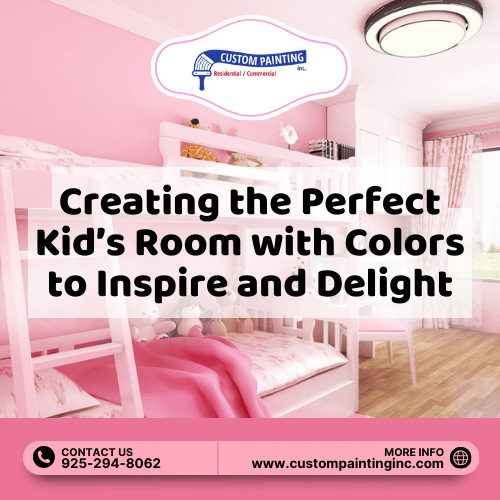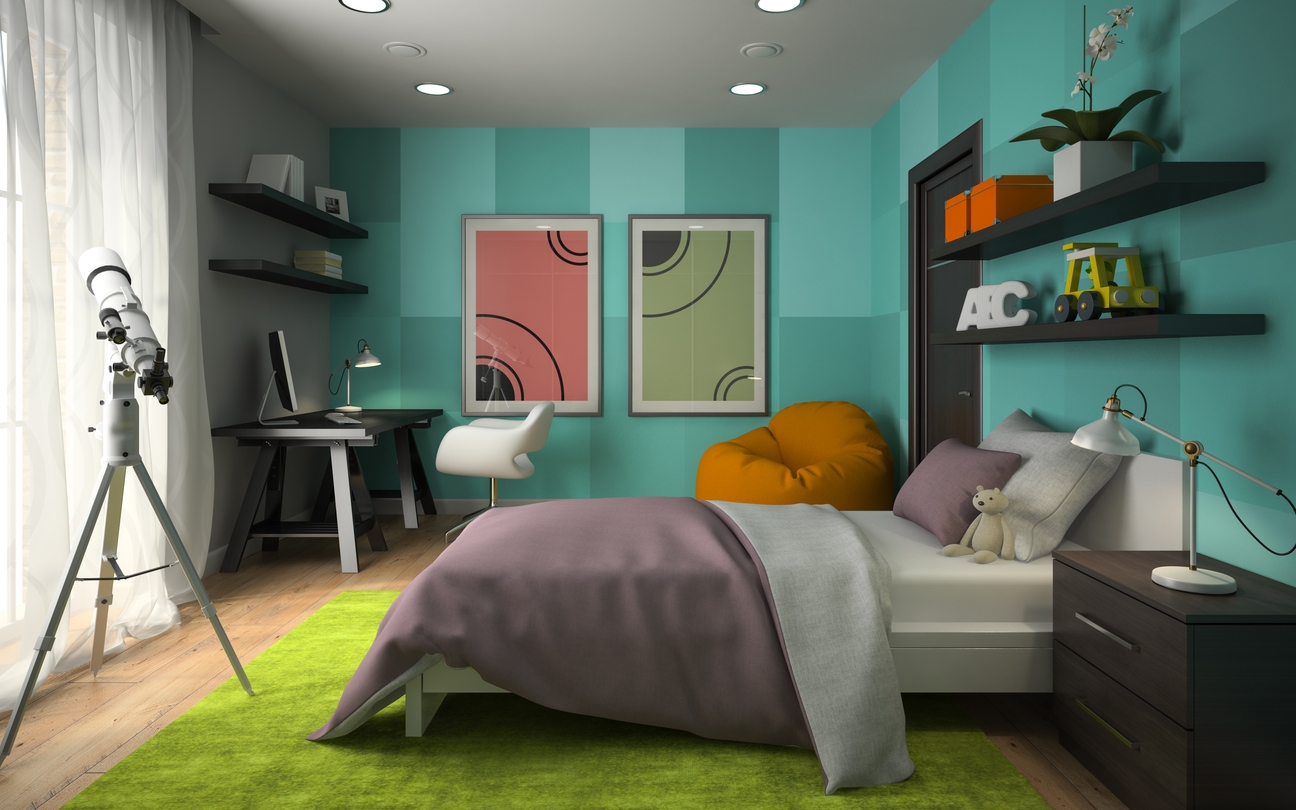Your child’s room plays a critical role in their development. It is more than a mere place for them to rest and play. Your child’s room should be a personal space for growth, creativity, and learning. It fosters independence and responsibility and provides a sense of security.
The environment we live in can have a profound impact on our mood, behavior, outlook, and emotional well-being. Colors, decor, and lighting play a significant part. It rings true for the colors in your child’s room.
Children are generally known to be extra sensitive and impressionable towards their surroundings. They are likely to respond favorably to bright and warm colors like yellow and red. These colors can stimulate their energy and enthusiasm. Dark and cool colors, on the other hand, tend to have a negative or “downtime” effect. With that in mind, consider the effect colors can have on your child’s environment for sleeping, playing, studying, and relaxation.
Understanding color psychology
Explanation of color psychology and its relevance to children
Color psychology studies how different colors influence human behavior and emotions. It’s especially relevant to children as they are highly responsive to visual stimuli. Colors can significantly impact their mood, behavior, and cognitive development.
Effects of various colors on children
- Red: Energy and excitement
-
- Red stimulates energy levels and excitement, often increasing heart rates and attention. It can be used to create a lively and dynamic environment. However, use red only in moderation to avoid overstimulation.
- Blue: Calmness and concentration
-
- Blue promotes calmness and concentration. It can help reduce anxiety and encourage a sense of peace. This aspect makes blue ideal for environments where focus is needed, such as study areas.
- Yellow: Cheerfulness and Intellect
-
- Yellow is associated with cheerfulness and intellectual stimulation. It can boost mood and creativity. This aspect makes yellow a good choice for play areas and learning spaces.
- Green: Harmony and growth
-
- Green represents harmony and growth, promoting a sense of balance and tranquility. It’s soothing and can enhance learning by providing a restful atmosphere.
- Orange: Confidence and friendliness
- Orange is linked to confidence and friendliness. It fosters social interaction and enthusiasm, making it suitable for communal spaces where children gather and play.
Age-specific responses to color
- Infants and toddlers (0-3 years): Bright, high-contrast colors like red and yellow are particularly engaging and help with visual development and stimulation.
- Preschoolers (3-5 years): Vibrant colors like blue and green can support cognitive and emotional growth. They aid in creating a balanced and nurturing environment.
- School-aged children (6+ years): More nuanced use of colors like blue and green can support concentration and relaxation. It is crucial for learning and emotional regulation.
Understanding and applying color psychology can help create environments that support the well-being and development of children at different stages.
Planning the color scheme
Steps to choosing the right colors for a child’s room based on age and Personality
1. Consider age:
- Infants and toddlers – Soft pastels and muted colors are calming and soothing.
- Preschoolers – Consider bright, primary colors that can stimulate creativity and energy.
- School-aged children – Apply a mix of vibrant and more sophisticated hues to match growing preferences and activities.
- Teenagers – Go for more mature, subdued colors or trendy palettes reflecting their evolving style.
2. Assess personality:
- Energetic and active – Bold, bright colors like red or orange.
- Calm and Reflective – Soft blues, greens, and neutrals.
- Creative and artistic – Vibrant and varied colors with opportunities for accent walls or creative designs.
- Introverted and quiet – Gentle, warm tones and calming pastels.
Importance of involving children in the color selection process
- Empowerment and ownership – Involving children helps them feel valued and respected, fostering a sense of ownership over their space.
- Expression of identity – It allows children to express their individuality and preferences, contributing to their emotional development.
- Increased comfort and enjoyment – A room reflecting their choices is more likely to be a comfortable and enjoyable space for them.
Balancing vibrant colors with neutral tones for versatility
- Versatility – Neutral tones on larger surfaces (walls, furniture) provide a timeless backdrop. It can effortlessly adapt to changing tastes and decor themes.
- Balance and harmony – Use vibrant colors as accents (pillows, artwork, rugs) to add personality and energy without overwhelming the space.
- Flexibility – This approach allows for easy updates and changes as the child grows, making the room adaptable to new interests and phases.
Practical tips for applying color
Ideas for incorporating color in children’s rooms
- Walls – Use bright or pastel shades as accents to create a lively atmosphere. Wall decals or murals can add fun elements without overwhelming the space.
- Furniture – Choose colorful pieces like beds, dressers, or shelves. Mix and match various colors for a fun and playful look.
- Accessories – Add vibrant rugs, curtains, and cushions. You can easily change these items as the child grows and their tastes evolve.
Tips on using themes without overdoing a single color
- Balance – Mix the primary theme color with neutral tones to avoid overwhelming the space.
- Variety – Incorporate different shades and tints of the theme color with complementary colors.
- Accents – Use the theme color for smaller accent pieces and accessories rather than large surfaces.
Role of Lighting in Enhancing Chosen Colors
- Natural light – Maximizes the brightness and actual appearance of colors. Ensure windows are unobstructed.
- Artificial lighting – Use warm or cool light bulbs depending on the desired mood. Layer lighting with ceiling lights, lamps, and fairy lights for a cozy and dynamic environment.
Creative applications
Innovative ideas for using color
- Color zones – Creating specific areas within a space defined by distinct colors can guide behavior and activity. For instance, a relaxing lounge area could be painted in calming blues, while a more energetic space could be painted in vibrant yellows or reds.
- Interactive walls – Using technology to make walls interactive with changing colors based on touch or movement. For example, walls that change color when touched can engage and delight children, encouraging exploration and play.
Using color to define areas in a child’s room
- Play area – Use bright, stimulating colors like primary reds, yellows, and blues to create an energetic and inviting play zone. These colors can enhance creativity and activity.
- Study area – Implement calm and focused colors such as greens and blues. These colors help your child to concentrate and create a serene environment conducive to learning and productivity.
- Sleep area – Use soft, soothing colors, such as pastels, and muted tones, such as light blues, greens, or lavenders. These colors promote relaxation and help create a peaceful atmosphere for sleeping.
Safety and sustainability
For your child’s room, choose safe, non-toxic paints and materials. Look for paints labeled as low or zero VOC (volatile organic compounds) to ensure minimal chemical exposure. Choose safe and chemical-free natural or organic paint options.
For sustainability, consider durable and easy-to-maintain eco-friendly materials. Select paints from renewable resources and ensure the furniture and decor are sustainably sourced. Choose easy-to-clean finishes, reducing the need for frequent repainting and thus minimizing waste.
Conclusion
A thoughtfully colored room for children offers numerous benefits, including enhancing mood, boosting creativity, and providing security and comfort. Colors can stimulate learning and concentration or promote relaxation and calmness, depending on the choice of hues.
Experiment and adapt color ideas to suit individual children’s needs. Every child is unique, so tailor the room’s colors and design to reflect their personality and preferences, creating an environment where they feel happy and thrive. Encourage your child to get involved in the color decision-making process. It empowers them, makes them feel valued, and ensures the space reflects their personality and preferences.
Custom Painting, Inc. is here to help you and your child choose the ideal color palette for their personal space. We also adopt an eco-friendly painting process that will leave your child’s room fresh, clean, and wonderfully painted. Call us at 925-686-0903 or message us here for a free job estimate.



